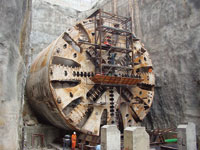 |
Periodic flooding of Kuala Lumpurs commercial center has dampened Malaysias ambitions for its capital to become a major international city. But by building a 9.7-kilometer- long water diversion tunnel, and putting a two-deck highway inside, local contractors are working to alleviate monsoon floods while showing a talent for novel engineering and smart financing.  Click here to view map
Click here to view map
 |
| Tough Cut. Tricky ground conditions required slurry-pressure TBMs. (Photo courtesy of SMART JV) |
Included as an afterthought, the unprecedented 3-km-long contractor-financed highway component is subsid-izing the $525-million Stormwater Management and Road Tunnel (SMART) project, bringing it within the governments means. On two levels, the road portion will run through roughly the central third of the tunnel.
Having sold the dual-purpose concept, the local joint venture, Syarikat Mengurus Air Banjir & Terowong Sdn. Bhd (SMART JV), had to garner missing skills to drive the 13.2-meter-dia bore through difficult karstic limestone. With $200 million of tunneling reportedly going well, SMART JVs technical gamble seems to have paid off. Whether it profits from its cash investment remains to be seen.
A radical cure for Kuala Lumpur's flooding became increasingly necessary as traditional mitigation measures became overwhelmed in recent years. As the city grew, river channels no longer could contain the water. Serious flash floods hit central Kuala Lumpur three times in 2001 and once two years later.
A key constraint to continuing channel enlarging is at the confluence of the Gombak and Klang rivers in the city center, where a profusion of buildings limit mitigation work. Further downstream, a low mass-transit bridge over the Klang poses a further obstacle.
Aware of the pressing need to deal with floods, SMART JV proposed building a water diversion tunnel from the Klang River, starting above the city center, and discharging in the south. The team drew on technical support from a joint venture of local design firm Sepakat Setia Perunding (Sdn) Bhd. with the U.K.s Mott MacDonald Group, London, the subsequent projects joint designers.
 |
| SIVALINGAM |
"When we put forward our tunnel concept, the government was not in favor of spending $525 million and requested a cheaper solution," says Param Sivalingam, SMART JVs general manager. The joint ventures solution in 2002 was to reduce the governments outlay by incorporating a road tunnel, which the contractor would finance.
Attracted by the idea, the Dept. of Irrigation and Drainage invited rival concepts. But the mixed-use tunnel option won "on the basis of technical strength and the financial proposals," says Sivalingam. There was no formal bidding for the contract, but "it was a matter of competing solutions," he says. After about six months of negotiations, the contract was signed in summer 2004. Flooding during that period "helped crystallize the thinking," he adds.
 |
| Junction. Contractor had to haul TBM through huge open pit excavated to accommodate highway connection. photo courtesy of SMART JV |
Under the innovative deal, SMART JV raised about $155 million, including its own equity, to finance the highway element, says Sivalingam. It will recover that investment through car tolls during the contracts 40-year duration. The joint venture also raised state-guaranteed loans for the governments contribution.
Most of the time the 11.8-m-internal-dia tunnel will be entirely dry. But several times a year, during moderate storms, water will be diverted into the lowest gallery, while traffic continues running in the two levels above. In worse conditions, perhaps annually, traffic will be excluded and water gates in shafts sealing the roads ends will be opened to move water. After about two days to clean up and deal with any damage, the road will reopen.
In full floods, water will be diverted at up to 290 cu m per sec from the Klang River and fed via a holding pond in the Gombak district into the tunnel. It will flow down the tunnels general 1:800 slope for storage at an upgraded old mining pond in Taman Desa, at the south end. From there, it will be released through a 500-m-long twin box culvert into the Kerayong River. Apart from diverting floods, the system can store 3 million cu m of water.
Conventionally, the tunnel will have galleries linking the two decks as emergency exits. But novel features are needed for the tunnels flood relief function. Ventilation equipment, for example, will be above water level at four ventilation shafts, with air flowing through nozzles in the tunnel sides.  Click here to view diagram
Click here to view diagram
In addition to water barriers at the vent shaft and escape galleries, there will be major gates at the tunnel ends. Normally, vertical gates in the highway tunnel upstream and downstream of the ramps will be closed. A third, standby gate also will be fitted at each end. Flap gates rising from the road deck will stop traffic at the tunnel entrances.
The roadways structure also is unusual "in that it is subjected to upwards and downward loads," says Arthur Darby, Mott MacDonalds divisional director. The road structure consists of two reinforced concrete decks cast integrally with side walls. Fixed to the tunnel by shear connectors, the box applies only vertical load on the bolted segmental lining. But because of the upward water pressure from the filling tunnel, the box itself will undergo bending moments in slab and walls.
When the gates open, water will enter from both ends, creating a transient upward pressure on decks, says Darby. To establish optimal balance between gate opening rates and structural loadings, BHR Group Ltd., Cranfield, U.K., ran surge analyses for the designers, he adds.
To keep the boring machines supplied along the tunnel base while the roadway is being built, the lower deck was raised, allowing for a 2.8-m invert, but limiting headroom above. Because the construction program is very tight, "they need to construct the lower deck while the TBM is still driving," says Darby. The...

Post a comment to this article
Report Abusive Comment